Healthcare for Intellectual Disabilities: Communication Strategies
VerifiedAdded on 2022/10/13
|12
|2910
|10
Report
AI Summary
This report delves into the complexities of healthcare for individuals with intellectual disabilities, focusing on effective communication strategies and the disparities in healthcare access. The report begins by examining the differences in communication approaches between two nurses using the ANSAT tool, highlighting the importance of therapeutic communication and patient autonomy. It then explores various communication strategies for promoting health literacy among individuals with intellectual disabilities, differentiating between receptive and expressive communication techniques. Finally, the report addresses the issue of inequitable healthcare services, discussing the barriers faced by people with disabilities in accessing healthcare and the initiatives aimed at improving their access and quality of care. The report emphasizes the need for healthcare professionals to develop skills in order to provide safe and responsive care, and for creating an empowered environment that promotes health literacy and well-being for individuals with intellectual disabilities.
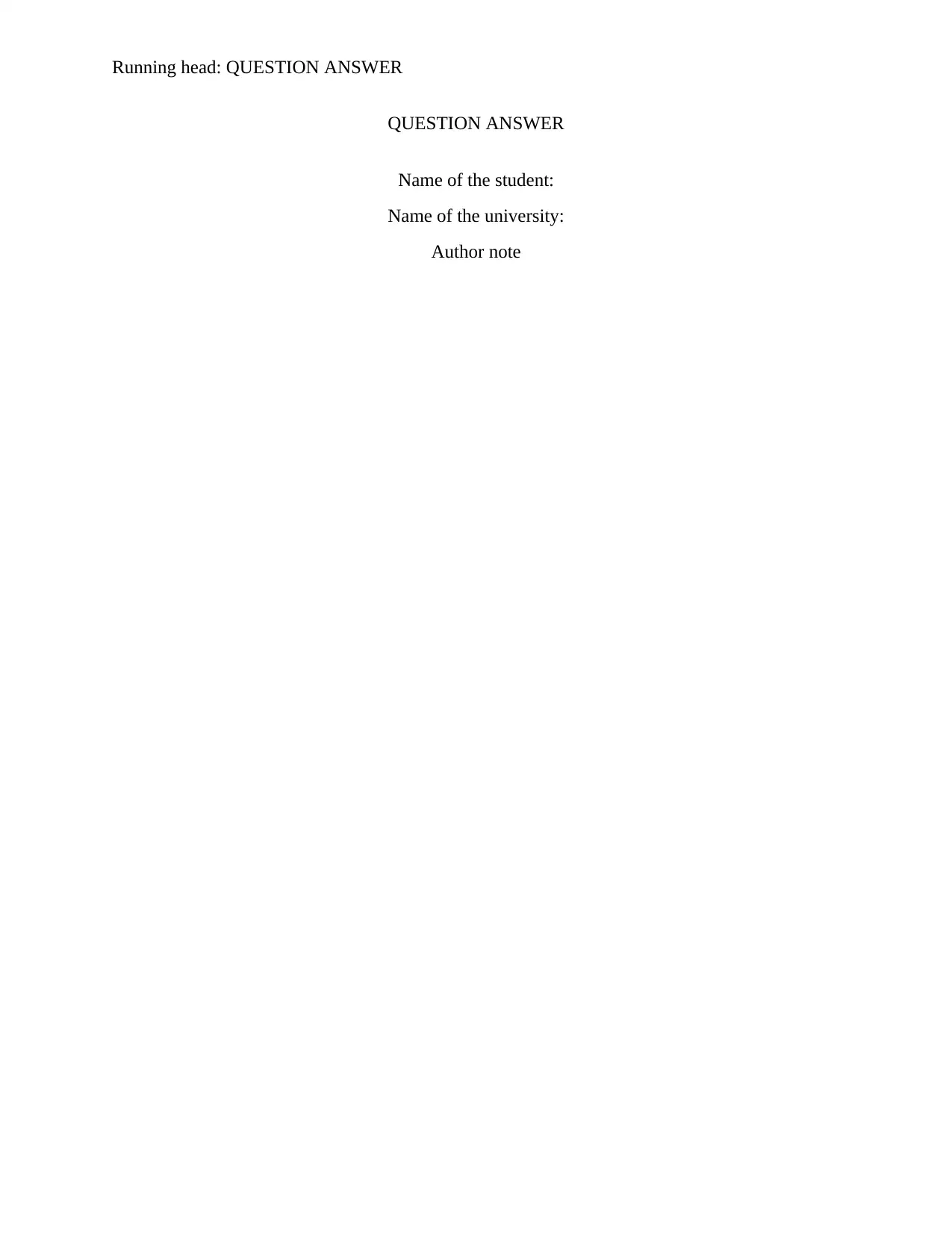
Running head: QUESTION ANSWER
QUESTION ANSWER
Name of the student:
Name of the university:
Author note
QUESTION ANSWER
Name of the student:
Name of the university:
Author note
Paraphrase This Document
Need a fresh take? Get an instant paraphrase of this document with our AI Paraphraser
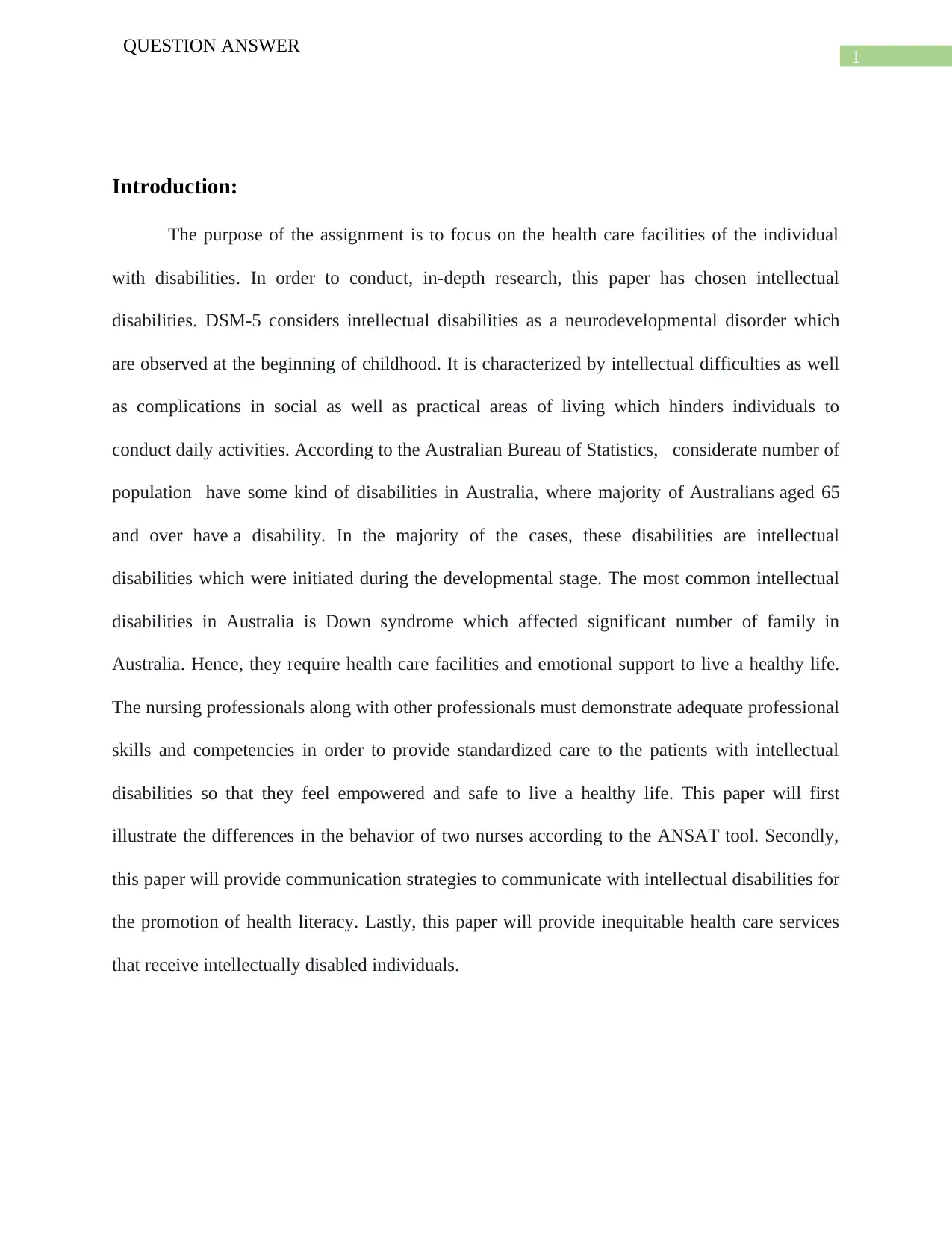
1
QUESTION ANSWER
Introduction:
The purpose of the assignment is to focus on the health care facilities of the individual
with disabilities. In order to conduct, in-depth research, this paper has chosen intellectual
disabilities. DSM-5 considers intellectual disabilities as a neurodevelopmental disorder which
are observed at the beginning of childhood. It is characterized by intellectual difficulties as well
as complications in social as well as practical areas of living which hinders individuals to
conduct daily activities. According to the Australian Bureau of Statistics, considerate number of
population have some kind of disabilities in Australia, where majority of Australians aged 65
and over have a disability. In the majority of the cases, these disabilities are intellectual
disabilities which were initiated during the developmental stage. The most common intellectual
disabilities in Australia is Down syndrome which affected significant number of family in
Australia. Hence, they require health care facilities and emotional support to live a healthy life.
The nursing professionals along with other professionals must demonstrate adequate professional
skills and competencies in order to provide standardized care to the patients with intellectual
disabilities so that they feel empowered and safe to live a healthy life. This paper will first
illustrate the differences in the behavior of two nurses according to the ANSAT tool. Secondly,
this paper will provide communication strategies to communicate with intellectual disabilities for
the promotion of health literacy. Lastly, this paper will provide inequitable health care services
that receive intellectually disabled individuals.
QUESTION ANSWER
Introduction:
The purpose of the assignment is to focus on the health care facilities of the individual
with disabilities. In order to conduct, in-depth research, this paper has chosen intellectual
disabilities. DSM-5 considers intellectual disabilities as a neurodevelopmental disorder which
are observed at the beginning of childhood. It is characterized by intellectual difficulties as well
as complications in social as well as practical areas of living which hinders individuals to
conduct daily activities. According to the Australian Bureau of Statistics, considerate number of
population have some kind of disabilities in Australia, where majority of Australians aged 65
and over have a disability. In the majority of the cases, these disabilities are intellectual
disabilities which were initiated during the developmental stage. The most common intellectual
disabilities in Australia is Down syndrome which affected significant number of family in
Australia. Hence, they require health care facilities and emotional support to live a healthy life.
The nursing professionals along with other professionals must demonstrate adequate professional
skills and competencies in order to provide standardized care to the patients with intellectual
disabilities so that they feel empowered and safe to live a healthy life. This paper will first
illustrate the differences in the behavior of two nurses according to the ANSAT tool. Secondly,
this paper will provide communication strategies to communicate with intellectual disabilities for
the promotion of health literacy. Lastly, this paper will provide inequitable health care services
that receive intellectually disabled individuals.
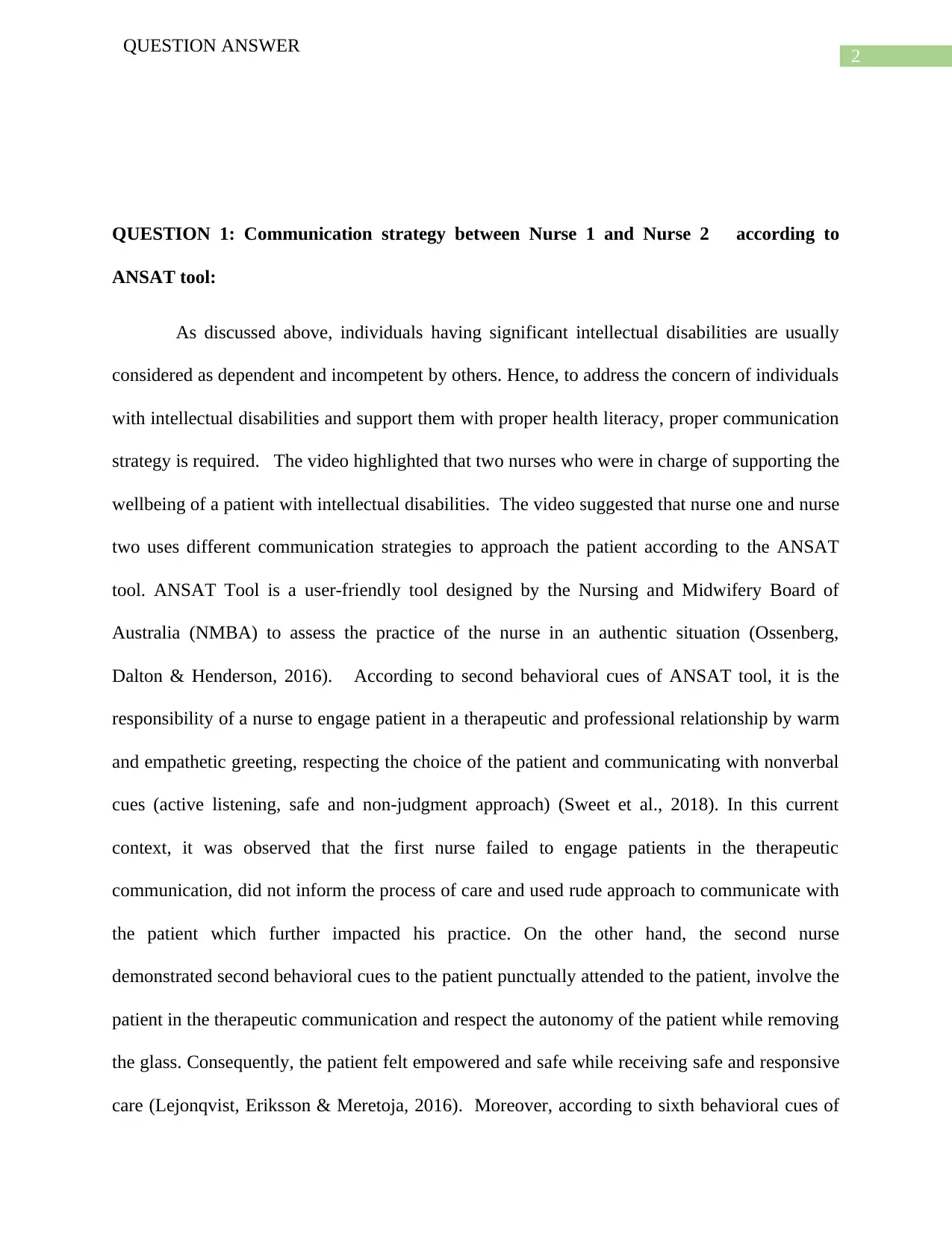
2
QUESTION ANSWER
QUESTION 1: Communication strategy between Nurse 1 and Nurse 2 according to
ANSAT tool:
As discussed above, individuals having significant intellectual disabilities are usually
considered as dependent and incompetent by others. Hence, to address the concern of individuals
with intellectual disabilities and support them with proper health literacy, proper communication
strategy is required. The video highlighted that two nurses who were in charge of supporting the
wellbeing of a patient with intellectual disabilities. The video suggested that nurse one and nurse
two uses different communication strategies to approach the patient according to the ANSAT
tool. ANSAT Tool is a user-friendly tool designed by the Nursing and Midwifery Board of
Australia (NMBA) to assess the practice of the nurse in an authentic situation (Ossenberg,
Dalton & Henderson, 2016). According to second behavioral cues of ANSAT tool, it is the
responsibility of a nurse to engage patient in a therapeutic and professional relationship by warm
and empathetic greeting, respecting the choice of the patient and communicating with nonverbal
cues (active listening, safe and non-judgment approach) (Sweet et al., 2018). In this current
context, it was observed that the first nurse failed to engage patients in the therapeutic
communication, did not inform the process of care and used rude approach to communicate with
the patient which further impacted his practice. On the other hand, the second nurse
demonstrated second behavioral cues to the patient punctually attended to the patient, involve the
patient in the therapeutic communication and respect the autonomy of the patient while removing
the glass. Consequently, the patient felt empowered and safe while receiving safe and responsive
care (Lejonqvist, Eriksson & Meretoja, 2016). Moreover, according to sixth behavioral cues of
QUESTION ANSWER
QUESTION 1: Communication strategy between Nurse 1 and Nurse 2 according to
ANSAT tool:
As discussed above, individuals having significant intellectual disabilities are usually
considered as dependent and incompetent by others. Hence, to address the concern of individuals
with intellectual disabilities and support them with proper health literacy, proper communication
strategy is required. The video highlighted that two nurses who were in charge of supporting the
wellbeing of a patient with intellectual disabilities. The video suggested that nurse one and nurse
two uses different communication strategies to approach the patient according to the ANSAT
tool. ANSAT Tool is a user-friendly tool designed by the Nursing and Midwifery Board of
Australia (NMBA) to assess the practice of the nurse in an authentic situation (Ossenberg,
Dalton & Henderson, 2016). According to second behavioral cues of ANSAT tool, it is the
responsibility of a nurse to engage patient in a therapeutic and professional relationship by warm
and empathetic greeting, respecting the choice of the patient and communicating with nonverbal
cues (active listening, safe and non-judgment approach) (Sweet et al., 2018). In this current
context, it was observed that the first nurse failed to engage patients in the therapeutic
communication, did not inform the process of care and used rude approach to communicate with
the patient which further impacted his practice. On the other hand, the second nurse
demonstrated second behavioral cues to the patient punctually attended to the patient, involve the
patient in the therapeutic communication and respect the autonomy of the patient while removing
the glass. Consequently, the patient felt empowered and safe while receiving safe and responsive
care (Lejonqvist, Eriksson & Meretoja, 2016). Moreover, according to sixth behavioral cues of
⊘ This is a preview!⊘
Do you want full access?
Subscribe today to unlock all pages.

Trusted by 1+ million students worldwide
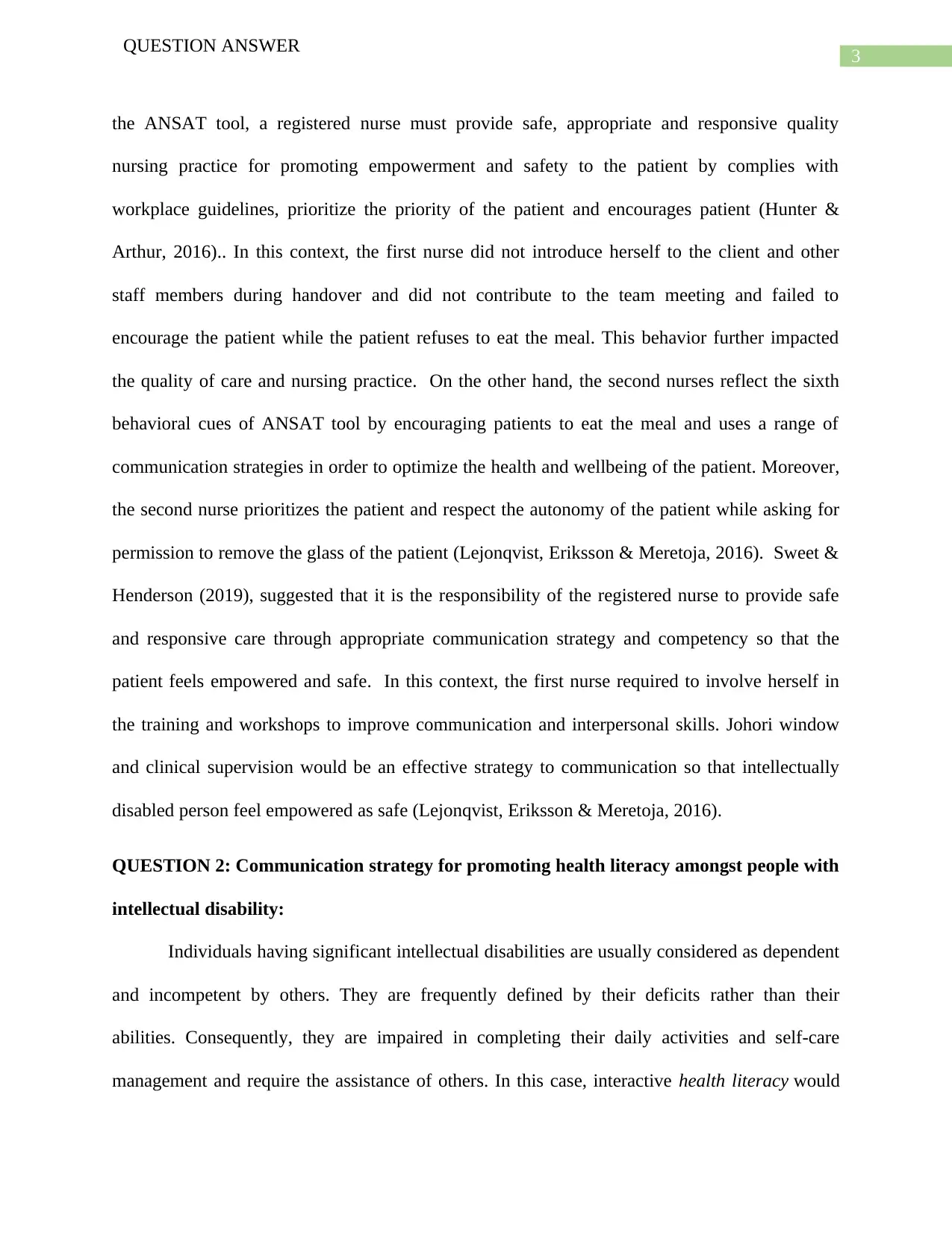
3
QUESTION ANSWER
the ANSAT tool, a registered nurse must provide safe, appropriate and responsive quality
nursing practice for promoting empowerment and safety to the patient by complies with
workplace guidelines, prioritize the priority of the patient and encourages patient (Hunter &
Arthur, 2016).. In this context, the first nurse did not introduce herself to the client and other
staff members during handover and did not contribute to the team meeting and failed to
encourage the patient while the patient refuses to eat the meal. This behavior further impacted
the quality of care and nursing practice. On the other hand, the second nurses reflect the sixth
behavioral cues of ANSAT tool by encouraging patients to eat the meal and uses a range of
communication strategies in order to optimize the health and wellbeing of the patient. Moreover,
the second nurse prioritizes the patient and respect the autonomy of the patient while asking for
permission to remove the glass of the patient (Lejonqvist, Eriksson & Meretoja, 2016). Sweet &
Henderson (2019), suggested that it is the responsibility of the registered nurse to provide safe
and responsive care through appropriate communication strategy and competency so that the
patient feels empowered and safe. In this context, the first nurse required to involve herself in
the training and workshops to improve communication and interpersonal skills. Johori window
and clinical supervision would be an effective strategy to communication so that intellectually
disabled person feel empowered as safe (Lejonqvist, Eriksson & Meretoja, 2016).
QUESTION 2: Communication strategy for promoting health literacy amongst people with
intellectual disability:
Individuals having significant intellectual disabilities are usually considered as dependent
and incompetent by others. They are frequently defined by their deficits rather than their
abilities. Consequently, they are impaired in completing their daily activities and self-care
management and require the assistance of others. In this case, interactive health literacy would
QUESTION ANSWER
the ANSAT tool, a registered nurse must provide safe, appropriate and responsive quality
nursing practice for promoting empowerment and safety to the patient by complies with
workplace guidelines, prioritize the priority of the patient and encourages patient (Hunter &
Arthur, 2016).. In this context, the first nurse did not introduce herself to the client and other
staff members during handover and did not contribute to the team meeting and failed to
encourage the patient while the patient refuses to eat the meal. This behavior further impacted
the quality of care and nursing practice. On the other hand, the second nurses reflect the sixth
behavioral cues of ANSAT tool by encouraging patients to eat the meal and uses a range of
communication strategies in order to optimize the health and wellbeing of the patient. Moreover,
the second nurse prioritizes the patient and respect the autonomy of the patient while asking for
permission to remove the glass of the patient (Lejonqvist, Eriksson & Meretoja, 2016). Sweet &
Henderson (2019), suggested that it is the responsibility of the registered nurse to provide safe
and responsive care through appropriate communication strategy and competency so that the
patient feels empowered and safe. In this context, the first nurse required to involve herself in
the training and workshops to improve communication and interpersonal skills. Johori window
and clinical supervision would be an effective strategy to communication so that intellectually
disabled person feel empowered as safe (Lejonqvist, Eriksson & Meretoja, 2016).
QUESTION 2: Communication strategy for promoting health literacy amongst people with
intellectual disability:
Individuals having significant intellectual disabilities are usually considered as dependent
and incompetent by others. They are frequently defined by their deficits rather than their
abilities. Consequently, they are impaired in completing their daily activities and self-care
management and require the assistance of others. In this case, interactive health literacy would
Paraphrase This Document
Need a fresh take? Get an instant paraphrase of this document with our AI Paraphraser
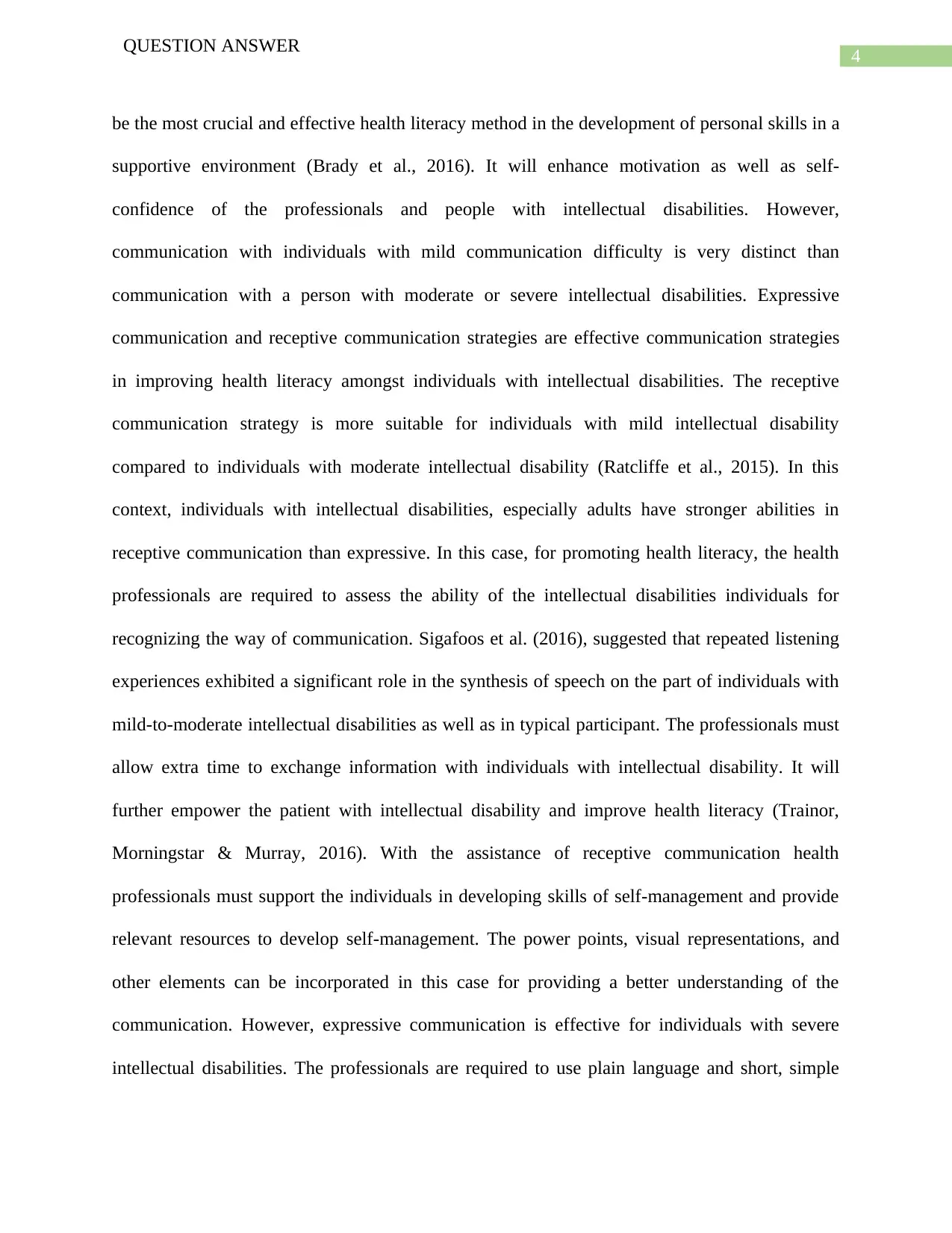
4
QUESTION ANSWER
be the most crucial and effective health literacy method in the development of personal skills in a
supportive environment (Brady et al., 2016). It will enhance motivation as well as self-
confidence of the professionals and people with intellectual disabilities. However,
communication with individuals with mild communication difficulty is very distinct than
communication with a person with moderate or severe intellectual disabilities. Expressive
communication and receptive communication strategies are effective communication strategies
in improving health literacy amongst individuals with intellectual disabilities. The receptive
communication strategy is more suitable for individuals with mild intellectual disability
compared to individuals with moderate intellectual disability (Ratcliffe et al., 2015). In this
context, individuals with intellectual disabilities, especially adults have stronger abilities in
receptive communication than expressive. In this case, for promoting health literacy, the health
professionals are required to assess the ability of the intellectual disabilities individuals for
recognizing the way of communication. Sigafoos et al. (2016), suggested that repeated listening
experiences exhibited a significant role in the synthesis of speech on the part of individuals with
mild-to-moderate intellectual disabilities as well as in typical participant. The professionals must
allow extra time to exchange information with individuals with intellectual disability. It will
further empower the patient with intellectual disability and improve health literacy (Trainor,
Morningstar & Murray, 2016). With the assistance of receptive communication health
professionals must support the individuals in developing skills of self-management and provide
relevant resources to develop self-management. The power points, visual representations, and
other elements can be incorporated in this case for providing a better understanding of the
communication. However, expressive communication is effective for individuals with severe
intellectual disabilities. The professionals are required to use plain language and short, simple
QUESTION ANSWER
be the most crucial and effective health literacy method in the development of personal skills in a
supportive environment (Brady et al., 2016). It will enhance motivation as well as self-
confidence of the professionals and people with intellectual disabilities. However,
communication with individuals with mild communication difficulty is very distinct than
communication with a person with moderate or severe intellectual disabilities. Expressive
communication and receptive communication strategies are effective communication strategies
in improving health literacy amongst individuals with intellectual disabilities. The receptive
communication strategy is more suitable for individuals with mild intellectual disability
compared to individuals with moderate intellectual disability (Ratcliffe et al., 2015). In this
context, individuals with intellectual disabilities, especially adults have stronger abilities in
receptive communication than expressive. In this case, for promoting health literacy, the health
professionals are required to assess the ability of the intellectual disabilities individuals for
recognizing the way of communication. Sigafoos et al. (2016), suggested that repeated listening
experiences exhibited a significant role in the synthesis of speech on the part of individuals with
mild-to-moderate intellectual disabilities as well as in typical participant. The professionals must
allow extra time to exchange information with individuals with intellectual disability. It will
further empower the patient with intellectual disability and improve health literacy (Trainor,
Morningstar & Murray, 2016). With the assistance of receptive communication health
professionals must support the individuals in developing skills of self-management and provide
relevant resources to develop self-management. The power points, visual representations, and
other elements can be incorporated in this case for providing a better understanding of the
communication. However, expressive communication is effective for individuals with severe
intellectual disabilities. The professionals are required to use plain language and short, simple
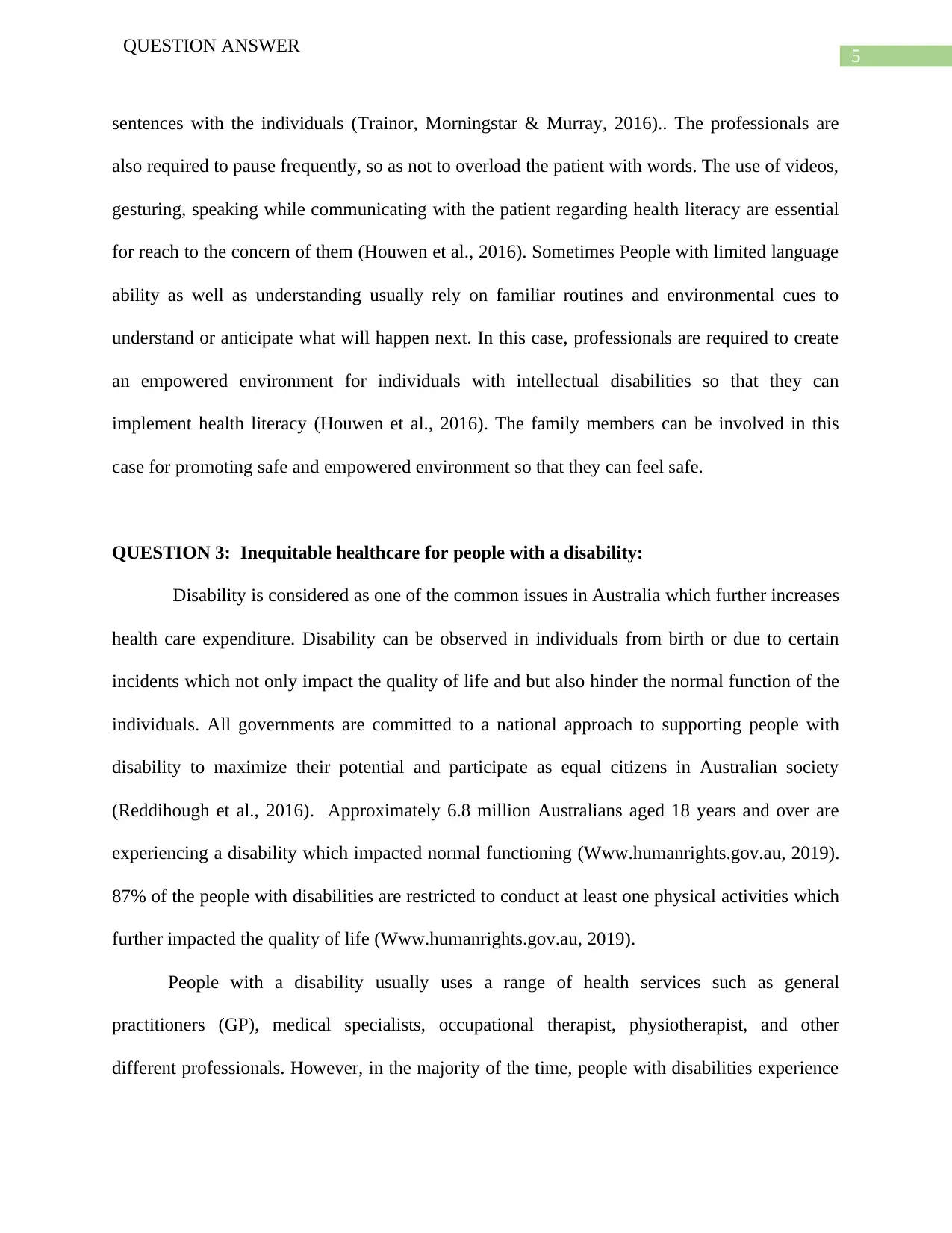
5
QUESTION ANSWER
sentences with the individuals (Trainor, Morningstar & Murray, 2016).. The professionals are
also required to pause frequently, so as not to overload the patient with words. The use of videos,
gesturing, speaking while communicating with the patient regarding health literacy are essential
for reach to the concern of them (Houwen et al., 2016). Sometimes People with limited language
ability as well as understanding usually rely on familiar routines and environmental cues to
understand or anticipate what will happen next. In this case, professionals are required to create
an empowered environment for individuals with intellectual disabilities so that they can
implement health literacy (Houwen et al., 2016). The family members can be involved in this
case for promoting safe and empowered environment so that they can feel safe.
QUESTION 3: Inequitable healthcare for people with a disability:
Disability is considered as one of the common issues in Australia which further increases
health care expenditure. Disability can be observed in individuals from birth or due to certain
incidents which not only impact the quality of life and but also hinder the normal function of the
individuals. All governments are committed to a national approach to supporting people with
disability to maximize their potential and participate as equal citizens in Australian society
(Reddihough et al., 2016). Approximately 6.8 million Australians aged 18 years and over are
experiencing a disability which impacted normal functioning (Www.humanrights.gov.au, 2019).
87% of the people with disabilities are restricted to conduct at least one physical activities which
further impacted the quality of life (Www.humanrights.gov.au, 2019).
People with a disability usually uses a range of health services such as general
practitioners (GP), medical specialists, occupational therapist, physiotherapist, and other
different professionals. However, in the majority of the time, people with disabilities experience
QUESTION ANSWER
sentences with the individuals (Trainor, Morningstar & Murray, 2016).. The professionals are
also required to pause frequently, so as not to overload the patient with words. The use of videos,
gesturing, speaking while communicating with the patient regarding health literacy are essential
for reach to the concern of them (Houwen et al., 2016). Sometimes People with limited language
ability as well as understanding usually rely on familiar routines and environmental cues to
understand or anticipate what will happen next. In this case, professionals are required to create
an empowered environment for individuals with intellectual disabilities so that they can
implement health literacy (Houwen et al., 2016). The family members can be involved in this
case for promoting safe and empowered environment so that they can feel safe.
QUESTION 3: Inequitable healthcare for people with a disability:
Disability is considered as one of the common issues in Australia which further increases
health care expenditure. Disability can be observed in individuals from birth or due to certain
incidents which not only impact the quality of life and but also hinder the normal function of the
individuals. All governments are committed to a national approach to supporting people with
disability to maximize their potential and participate as equal citizens in Australian society
(Reddihough et al., 2016). Approximately 6.8 million Australians aged 18 years and over are
experiencing a disability which impacted normal functioning (Www.humanrights.gov.au, 2019).
87% of the people with disabilities are restricted to conduct at least one physical activities which
further impacted the quality of life (Www.humanrights.gov.au, 2019).
People with a disability usually uses a range of health services such as general
practitioners (GP), medical specialists, occupational therapist, physiotherapist, and other
different professionals. However, in the majority of the time, people with disabilities experience
⊘ This is a preview!⊘
Do you want full access?
Subscribe today to unlock all pages.

Trusted by 1+ million students worldwide
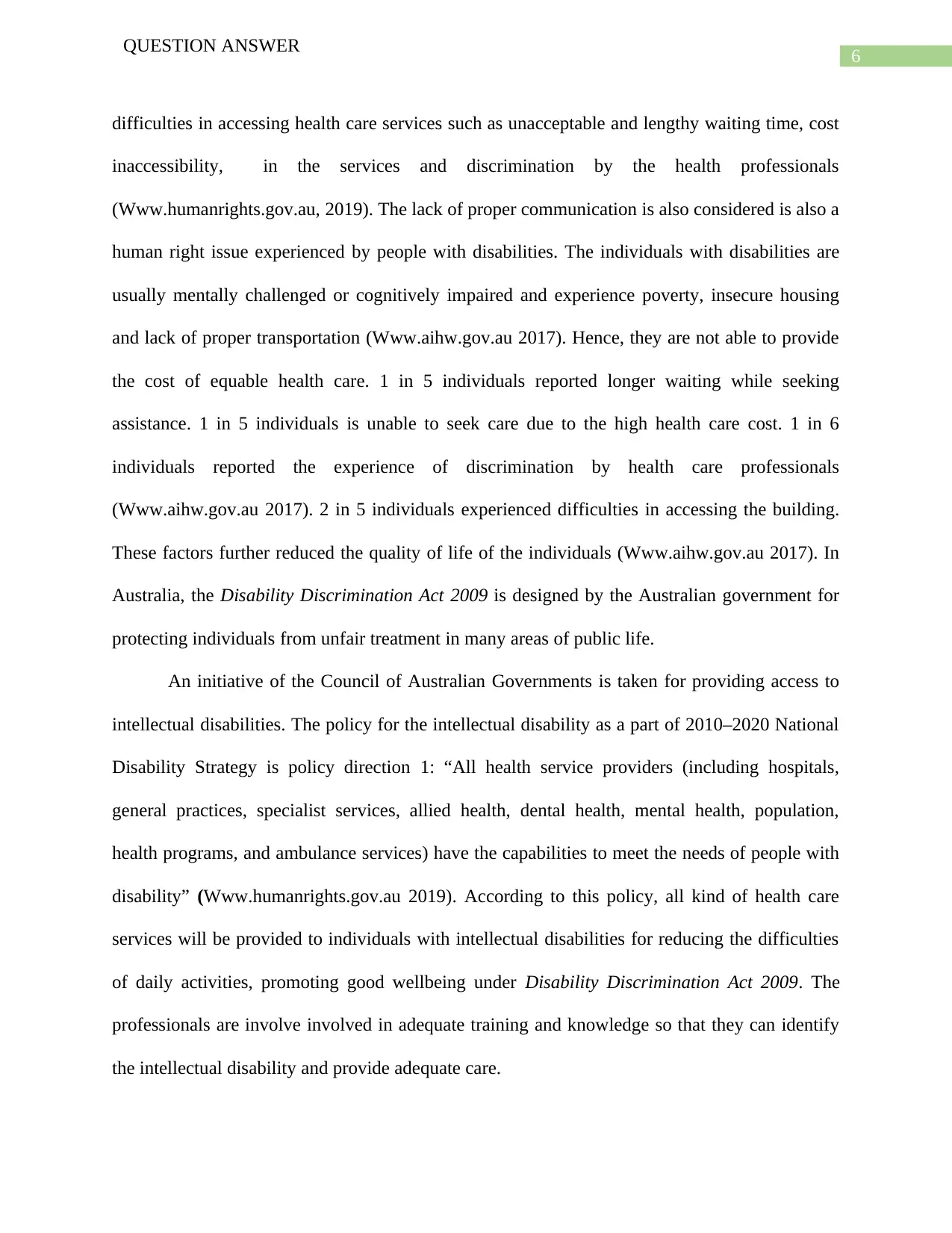
6
QUESTION ANSWER
difficulties in accessing health care services such as unacceptable and lengthy waiting time, cost
inaccessibility, in the services and discrimination by the health professionals
(Www.humanrights.gov.au, 2019). The lack of proper communication is also considered is also a
human right issue experienced by people with disabilities. The individuals with disabilities are
usually mentally challenged or cognitively impaired and experience poverty, insecure housing
and lack of proper transportation (Www.aihw.gov.au 2017). Hence, they are not able to provide
the cost of equable health care. 1 in 5 individuals reported longer waiting while seeking
assistance. 1 in 5 individuals is unable to seek care due to the high health care cost. 1 in 6
individuals reported the experience of discrimination by health care professionals
(Www.aihw.gov.au 2017). 2 in 5 individuals experienced difficulties in accessing the building.
These factors further reduced the quality of life of the individuals (Www.aihw.gov.au 2017). In
Australia, the Disability Discrimination Act 2009 is designed by the Australian government for
protecting individuals from unfair treatment in many areas of public life.
An initiative of the Council of Australian Governments is taken for providing access to
intellectual disabilities. The policy for the intellectual disability as a part of 2010–2020 National
Disability Strategy is policy direction 1: “All health service providers (including hospitals,
general practices, specialist services, allied health, dental health, mental health, population,
health programs, and ambulance services) have the capabilities to meet the needs of people with
disability” (Www.humanrights.gov.au 2019). According to this policy, all kind of health care
services will be provided to individuals with intellectual disabilities for reducing the difficulties
of daily activities, promoting good wellbeing under Disability Discrimination Act 2009. The
professionals are involve involved in adequate training and knowledge so that they can identify
the intellectual disability and provide adequate care.
QUESTION ANSWER
difficulties in accessing health care services such as unacceptable and lengthy waiting time, cost
inaccessibility, in the services and discrimination by the health professionals
(Www.humanrights.gov.au, 2019). The lack of proper communication is also considered is also a
human right issue experienced by people with disabilities. The individuals with disabilities are
usually mentally challenged or cognitively impaired and experience poverty, insecure housing
and lack of proper transportation (Www.aihw.gov.au 2017). Hence, they are not able to provide
the cost of equable health care. 1 in 5 individuals reported longer waiting while seeking
assistance. 1 in 5 individuals is unable to seek care due to the high health care cost. 1 in 6
individuals reported the experience of discrimination by health care professionals
(Www.aihw.gov.au 2017). 2 in 5 individuals experienced difficulties in accessing the building.
These factors further reduced the quality of life of the individuals (Www.aihw.gov.au 2017). In
Australia, the Disability Discrimination Act 2009 is designed by the Australian government for
protecting individuals from unfair treatment in many areas of public life.
An initiative of the Council of Australian Governments is taken for providing access to
intellectual disabilities. The policy for the intellectual disability as a part of 2010–2020 National
Disability Strategy is policy direction 1: “All health service providers (including hospitals,
general practices, specialist services, allied health, dental health, mental health, population,
health programs, and ambulance services) have the capabilities to meet the needs of people with
disability” (Www.humanrights.gov.au 2019). According to this policy, all kind of health care
services will be provided to individuals with intellectual disabilities for reducing the difficulties
of daily activities, promoting good wellbeing under Disability Discrimination Act 2009. The
professionals are involve involved in adequate training and knowledge so that they can identify
the intellectual disability and provide adequate care.
Paraphrase This Document
Need a fresh take? Get an instant paraphrase of this document with our AI Paraphraser
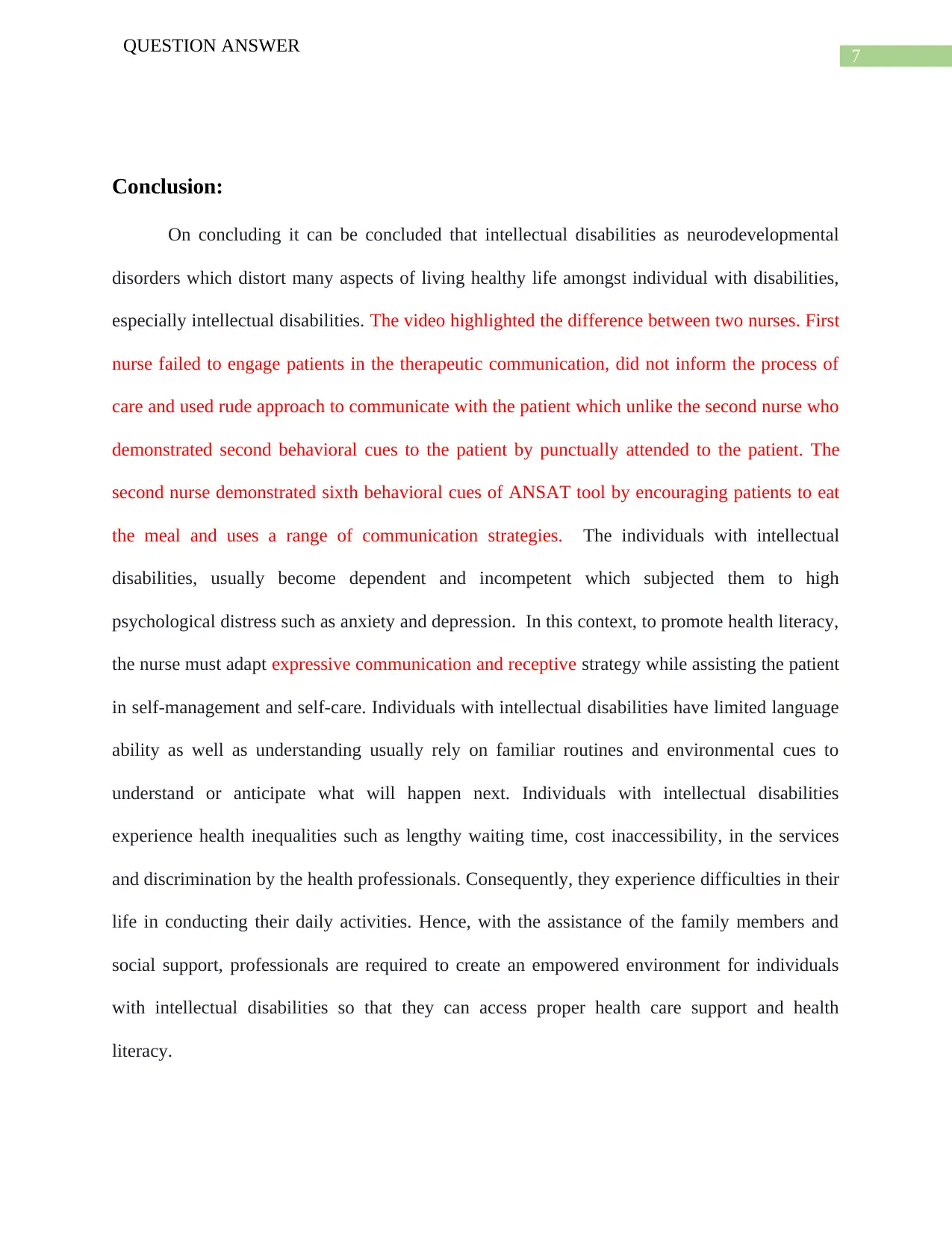
7
QUESTION ANSWER
Conclusion:
On concluding it can be concluded that intellectual disabilities as neurodevelopmental
disorders which distort many aspects of living healthy life amongst individual with disabilities,
especially intellectual disabilities. The video highlighted the difference between two nurses. First
nurse failed to engage patients in the therapeutic communication, did not inform the process of
care and used rude approach to communicate with the patient which unlike the second nurse who
demonstrated second behavioral cues to the patient by punctually attended to the patient. The
second nurse demonstrated sixth behavioral cues of ANSAT tool by encouraging patients to eat
the meal and uses a range of communication strategies. The individuals with intellectual
disabilities, usually become dependent and incompetent which subjected them to high
psychological distress such as anxiety and depression. In this context, to promote health literacy,
the nurse must adapt expressive communication and receptive strategy while assisting the patient
in self-management and self-care. Individuals with intellectual disabilities have limited language
ability as well as understanding usually rely on familiar routines and environmental cues to
understand or anticipate what will happen next. Individuals with intellectual disabilities
experience health inequalities such as lengthy waiting time, cost inaccessibility, in the services
and discrimination by the health professionals. Consequently, they experience difficulties in their
life in conducting their daily activities. Hence, with the assistance of the family members and
social support, professionals are required to create an empowered environment for individuals
with intellectual disabilities so that they can access proper health care support and health
literacy.
QUESTION ANSWER
Conclusion:
On concluding it can be concluded that intellectual disabilities as neurodevelopmental
disorders which distort many aspects of living healthy life amongst individual with disabilities,
especially intellectual disabilities. The video highlighted the difference between two nurses. First
nurse failed to engage patients in the therapeutic communication, did not inform the process of
care and used rude approach to communicate with the patient which unlike the second nurse who
demonstrated second behavioral cues to the patient by punctually attended to the patient. The
second nurse demonstrated sixth behavioral cues of ANSAT tool by encouraging patients to eat
the meal and uses a range of communication strategies. The individuals with intellectual
disabilities, usually become dependent and incompetent which subjected them to high
psychological distress such as anxiety and depression. In this context, to promote health literacy,
the nurse must adapt expressive communication and receptive strategy while assisting the patient
in self-management and self-care. Individuals with intellectual disabilities have limited language
ability as well as understanding usually rely on familiar routines and environmental cues to
understand or anticipate what will happen next. Individuals with intellectual disabilities
experience health inequalities such as lengthy waiting time, cost inaccessibility, in the services
and discrimination by the health professionals. Consequently, they experience difficulties in their
life in conducting their daily activities. Hence, with the assistance of the family members and
social support, professionals are required to create an empowered environment for individuals
with intellectual disabilities so that they can access proper health care support and health
literacy.

8
QUESTION ANSWER
QUESTION ANSWER
⊘ This is a preview!⊘
Do you want full access?
Subscribe today to unlock all pages.

Trusted by 1+ million students worldwide
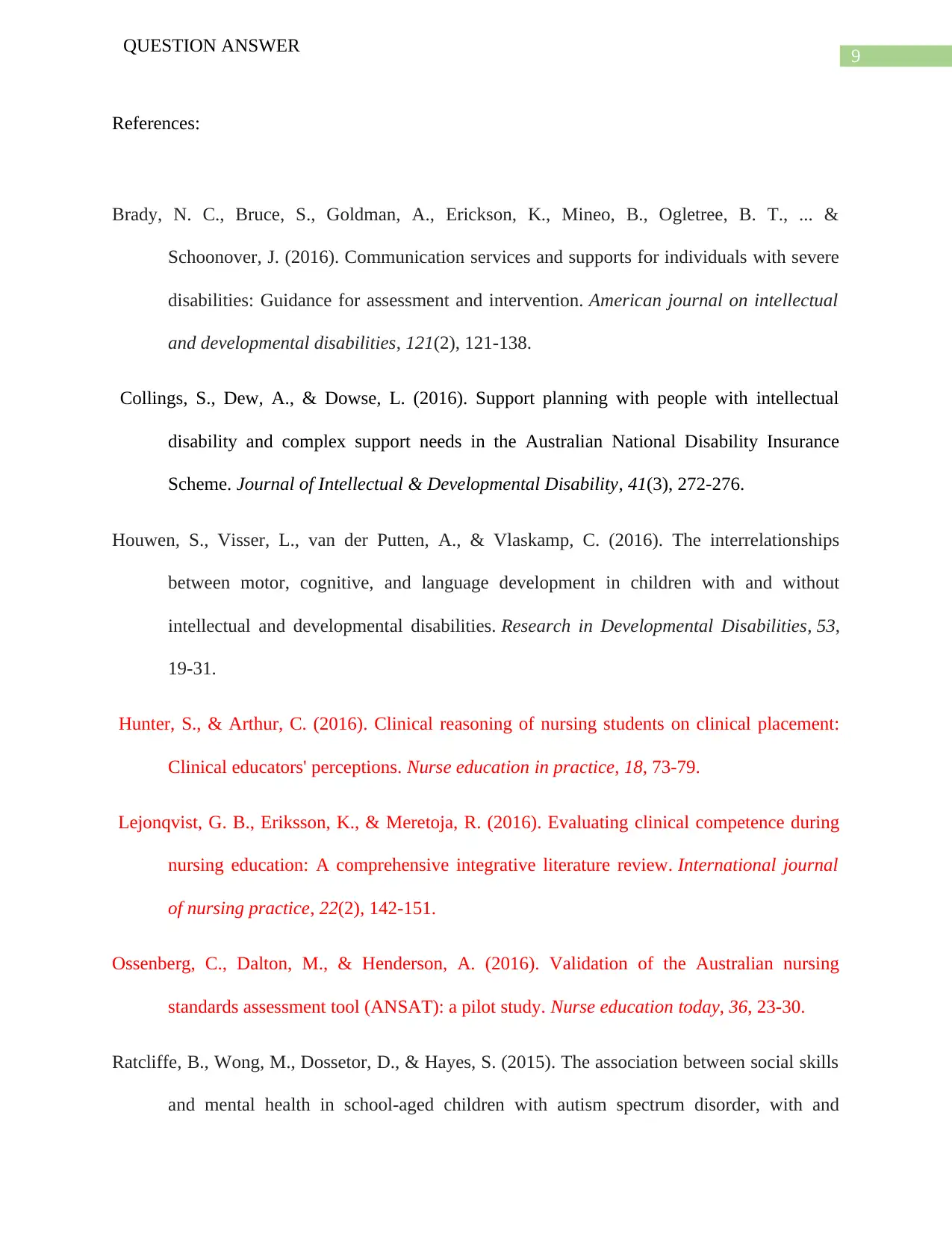
9
QUESTION ANSWER
References:
Brady, N. C., Bruce, S., Goldman, A., Erickson, K., Mineo, B., Ogletree, B. T., ... &
Schoonover, J. (2016). Communication services and supports for individuals with severe
disabilities: Guidance for assessment and intervention. American journal on intellectual
and developmental disabilities, 121(2), 121-138.
Collings, S., Dew, A., & Dowse, L. (2016). Support planning with people with intellectual
disability and complex support needs in the Australian National Disability Insurance
Scheme. Journal of Intellectual & Developmental Disability, 41(3), 272-276.
Houwen, S., Visser, L., van der Putten, A., & Vlaskamp, C. (2016). The interrelationships
between motor, cognitive, and language development in children with and without
intellectual and developmental disabilities. Research in Developmental Disabilities, 53,
19-31.
Hunter, S., & Arthur, C. (2016). Clinical reasoning of nursing students on clinical placement:
Clinical educators' perceptions. Nurse education in practice, 18, 73-79.
Lejonqvist, G. B., Eriksson, K., & Meretoja, R. (2016). Evaluating clinical competence during
nursing education: A comprehensive integrative literature review. International journal
of nursing practice, 22(2), 142-151.
Ossenberg, C., Dalton, M., & Henderson, A. (2016). Validation of the Australian nursing
standards assessment tool (ANSAT): a pilot study. Nurse education today, 36, 23-30.
Ratcliffe, B., Wong, M., Dossetor, D., & Hayes, S. (2015). The association between social skills
and mental health in school-aged children with autism spectrum disorder, with and
QUESTION ANSWER
References:
Brady, N. C., Bruce, S., Goldman, A., Erickson, K., Mineo, B., Ogletree, B. T., ... &
Schoonover, J. (2016). Communication services and supports for individuals with severe
disabilities: Guidance for assessment and intervention. American journal on intellectual
and developmental disabilities, 121(2), 121-138.
Collings, S., Dew, A., & Dowse, L. (2016). Support planning with people with intellectual
disability and complex support needs in the Australian National Disability Insurance
Scheme. Journal of Intellectual & Developmental Disability, 41(3), 272-276.
Houwen, S., Visser, L., van der Putten, A., & Vlaskamp, C. (2016). The interrelationships
between motor, cognitive, and language development in children with and without
intellectual and developmental disabilities. Research in Developmental Disabilities, 53,
19-31.
Hunter, S., & Arthur, C. (2016). Clinical reasoning of nursing students on clinical placement:
Clinical educators' perceptions. Nurse education in practice, 18, 73-79.
Lejonqvist, G. B., Eriksson, K., & Meretoja, R. (2016). Evaluating clinical competence during
nursing education: A comprehensive integrative literature review. International journal
of nursing practice, 22(2), 142-151.
Ossenberg, C., Dalton, M., & Henderson, A. (2016). Validation of the Australian nursing
standards assessment tool (ANSAT): a pilot study. Nurse education today, 36, 23-30.
Ratcliffe, B., Wong, M., Dossetor, D., & Hayes, S. (2015). The association between social skills
and mental health in school-aged children with autism spectrum disorder, with and
Paraphrase This Document
Need a fresh take? Get an instant paraphrase of this document with our AI Paraphraser
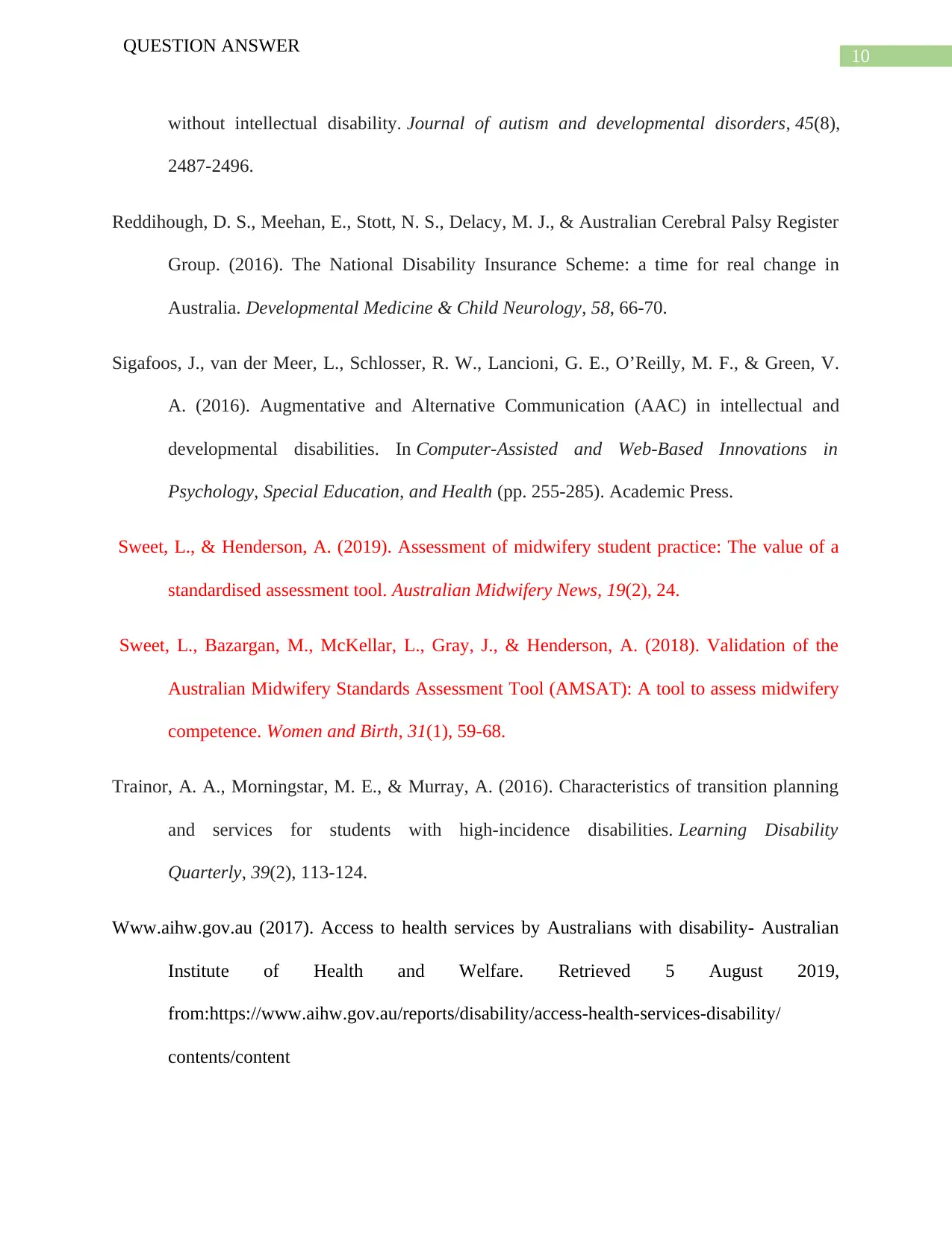
10
QUESTION ANSWER
without intellectual disability. Journal of autism and developmental disorders, 45(8),
2487-2496.
Reddihough, D. S., Meehan, E., Stott, N. S., Delacy, M. J., & Australian Cerebral Palsy Register
Group. (2016). The National Disability Insurance Scheme: a time for real change in
Australia. Developmental Medicine & Child Neurology, 58, 66-70.
Sigafoos, J., van der Meer, L., Schlosser, R. W., Lancioni, G. E., O’Reilly, M. F., & Green, V.
A. (2016). Augmentative and Alternative Communication (AAC) in intellectual and
developmental disabilities. In Computer-Assisted and Web-Based Innovations in
Psychology, Special Education, and Health (pp. 255-285). Academic Press.
Sweet, L., & Henderson, A. (2019). Assessment of midwifery student practice: The value of a
standardised assessment tool. Australian Midwifery News, 19(2), 24.
Sweet, L., Bazargan, M., McKellar, L., Gray, J., & Henderson, A. (2018). Validation of the
Australian Midwifery Standards Assessment Tool (AMSAT): A tool to assess midwifery
competence. Women and Birth, 31(1), 59-68.
Trainor, A. A., Morningstar, M. E., & Murray, A. (2016). Characteristics of transition planning
and services for students with high-incidence disabilities. Learning Disability
Quarterly, 39(2), 113-124.
Www.aihw.gov.au (2017). Access to health services by Australians with disability- Australian
Institute of Health and Welfare. Retrieved 5 August 2019,
from:https://www.aihw.gov.au/reports/disability/access-health-services-disability/
contents/content
QUESTION ANSWER
without intellectual disability. Journal of autism and developmental disorders, 45(8),
2487-2496.
Reddihough, D. S., Meehan, E., Stott, N. S., Delacy, M. J., & Australian Cerebral Palsy Register
Group. (2016). The National Disability Insurance Scheme: a time for real change in
Australia. Developmental Medicine & Child Neurology, 58, 66-70.
Sigafoos, J., van der Meer, L., Schlosser, R. W., Lancioni, G. E., O’Reilly, M. F., & Green, V.
A. (2016). Augmentative and Alternative Communication (AAC) in intellectual and
developmental disabilities. In Computer-Assisted and Web-Based Innovations in
Psychology, Special Education, and Health (pp. 255-285). Academic Press.
Sweet, L., & Henderson, A. (2019). Assessment of midwifery student practice: The value of a
standardised assessment tool. Australian Midwifery News, 19(2), 24.
Sweet, L., Bazargan, M., McKellar, L., Gray, J., & Henderson, A. (2018). Validation of the
Australian Midwifery Standards Assessment Tool (AMSAT): A tool to assess midwifery
competence. Women and Birth, 31(1), 59-68.
Trainor, A. A., Morningstar, M. E., & Murray, A. (2016). Characteristics of transition planning
and services for students with high-incidence disabilities. Learning Disability
Quarterly, 39(2), 113-124.
Www.aihw.gov.au (2017). Access to health services by Australians with disability- Australian
Institute of Health and Welfare. Retrieved 5 August 2019,
from:https://www.aihw.gov.au/reports/disability/access-health-services-disability/
contents/content
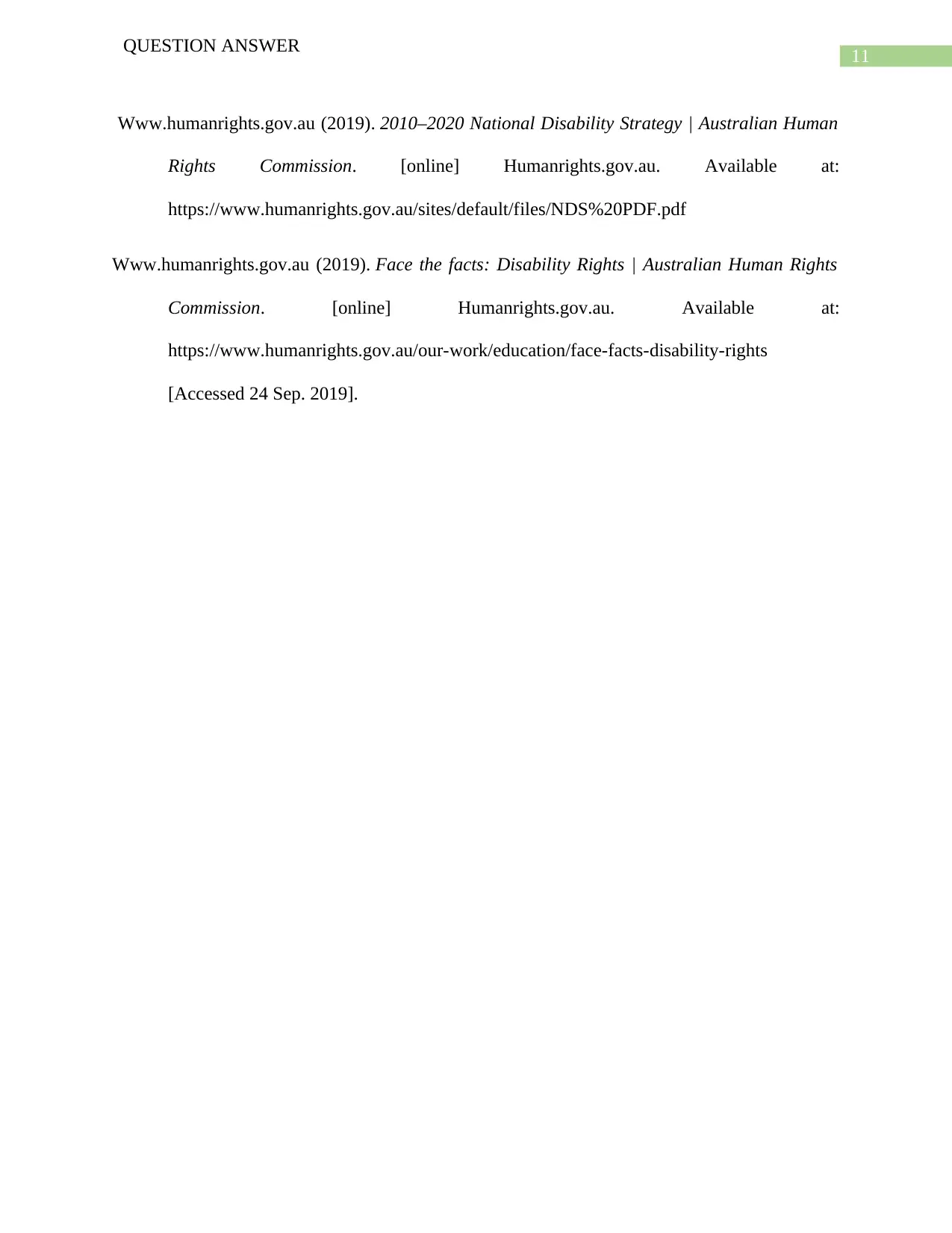
11
QUESTION ANSWER
Www.humanrights.gov.au (2019). 2010–2020 National Disability Strategy | Australian Human
Rights Commission. [online] Humanrights.gov.au. Available at:
https://www.humanrights.gov.au/sites/default/files/NDS%20PDF.pdf
Www.humanrights.gov.au (2019). Face the facts: Disability Rights | Australian Human Rights
Commission. [online] Humanrights.gov.au. Available at:
https://www.humanrights.gov.au/our-work/education/face-facts-disability-rights
[Accessed 24 Sep. 2019].
QUESTION ANSWER
Www.humanrights.gov.au (2019). 2010–2020 National Disability Strategy | Australian Human
Rights Commission. [online] Humanrights.gov.au. Available at:
https://www.humanrights.gov.au/sites/default/files/NDS%20PDF.pdf
Www.humanrights.gov.au (2019). Face the facts: Disability Rights | Australian Human Rights
Commission. [online] Humanrights.gov.au. Available at:
https://www.humanrights.gov.au/our-work/education/face-facts-disability-rights
[Accessed 24 Sep. 2019].
⊘ This is a preview!⊘
Do you want full access?
Subscribe today to unlock all pages.

Trusted by 1+ million students worldwide
1 out of 12
Related Documents
Your All-in-One AI-Powered Toolkit for Academic Success.
+13062052269
info@desklib.com
Available 24*7 on WhatsApp / Email
![[object Object]](/_next/static/media/star-bottom.7253800d.svg)
Unlock your academic potential
Copyright © 2020–2025 A2Z Services. All Rights Reserved. Developed and managed by ZUCOL.





